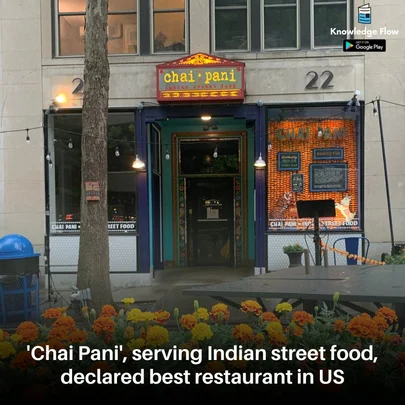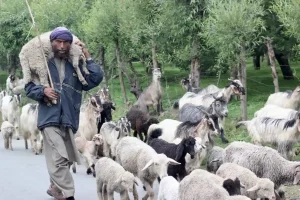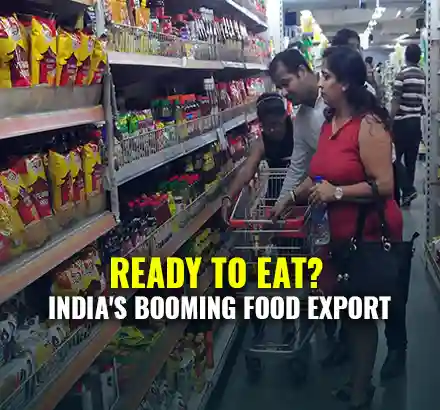This week, an Indian restaurant in North Carolina grabbed the headlines for being voted as America’s best restaurant by the James Beard Awards. As Chai Pani’s chef and owner Meherwan Irani claimed the award in Chicago, one thing was clear: Americans have finally discovered what Indians have always loved: chaat.
If chaat is finding a culturally diverse global audience today, its history is almost as cosmopolitan. For starters, it originated as an urban entertainment, something that street food lovers in all corners of the country may be surprised to know. The elite culture gradually percolated to other cities and towns of northern, eastern and western India, eventually becoming India’s best loved street food.
What we call chaat, in fact, is not just a melange to different flavours and textures layered up, but also a range of snacks that originated in different forms throughout history—starting from at least around 1000 AD, when we find mentions of the vataka or vada, the predecessor of dahi bada.
Some of the most popular chaat items however are later day inventions —the aloo tikki a spin on the English croquet/chop/cutlet. Not to mention the chaats of Mumbai and Calcutta that came up as the result of industrial migration, as these cities started attracting industrial labour in the late 19th and early 20th century. Bombay’s chaat was further influenced by UP migrants well into the 1960s as well as those from post-partition Sindh who made Maximum city its home.
As we trace this history of chaat, an important thing to remember is that it’s journey is one of constant regional innovation and evolution. Even today, chaat continues to evolve both on the streets as well as in cafes and restaurants where top chefs are layering up flavours and textures to surprise and delight.
While different chaat dishes evolved at different times, in different regions, through history, chaat as a snacking tradition of late afternoons and early evenings came about in Mughal Delhi.
Shahjahanabad, the urbane city Shahjahan built, became the hub of cultural and educated elite from different communities, as powerful political capitals tend to. Bankers, merchants, and bureaucrats became part of the political elite. And many of their foods became the basis of this vegetarian snacking tradition.
For these communities, eating out was restricted and eating with others that restaurants necessitated was often a cultural taboo. Sir Thomas Roe who had visited Jahangir’s court in Agra is known to have bitterly complained “they eat not willingly with us” about both high-ranking Muslim and Hindu officials in his correspondences which can be found in The Embassy of Sir Thomas Roe to the Court of the Great Mogul 1615-1619 when he failed to secure dinner invites from important courtiers (and even when he did, the host disappeared from the lavishly set table).
In Shahjahanabad, the new city, however, some of these cultural mores were loosened during festivities. Nouroze, the Persian new year that marks spring, was an important occasion. Since Akbar’s time, there had been a tradition of a fair for the womenfolk being hosted in the palace, where aristocratic women would put up stalls of merchandise —and food—to sell to each other and the emperor, the only male allowed.
સાલ મુબારક, નવરોઝ મુબારક Happy Parsi #Zoroastrian
#Nowruz
The Parsis in India last remembered to add the extra month in 1129 CE to keep Norūz on the vernal equinox on March 21st. As a result, in the Shenshai calendar (one of 3 Zoroastrian calendars) it occurs now in mid August. pic.twitter.com/CJqGrYqc8b— Shervin Farridnejad (@farridnejad) August 16, 2019
By Shahjahan’s time, this became an eight day festival that the Italian traveller Niccolao Manucci also mentions in his Storia Do Mogor. It is conjectured that chaat came up as entertaining small bites concocted to amuse the courtly ladies.
However, as the taste for chaat grew, there was one problem —none of the respectable, well-to-do women and their children would go to the bazaars to eat it. Instead, the stalls came to them!
Khomchewalle, as they were called till well into the 1950s and 1960s, moved around neighbourhoods with their cane baskets (khomche) from which they dispensed piquant kaanji-bade in spring, dahi-bade in summer, shakarkandi with lime in winter and gol gappe, filled with spicy water.
There was some etiquette (still followed by old families): First, chaat was an occasional evening’s entertainment only. Chatorapan, or fondness for these tangy bites (not home cooked) was frowned upon. Two, chaat was seasonal and usually eaten in spring or summer (it still is associated with Holi, the spring festival) as a cold food initially contrary to how we think of it as fried and hot.
Chaat masala evolved from belief in the therapeutic use of spices that both Unani and Ayurvedic systems upheld. Initially, chaat masala was just simple roasted cumin, hing and rock salt from the Himalayas, all thought to aid digestion with “cooling” properties, with some black pepper for the monsoon to warm up the system and protect from bad gut and seasonal ailments brought about by the rains. From these basic spices evolved more complex formulations that every chaatwallah boasted of; chillies were incorporated only much later in the later Mughal period.
The oldest chaat is perhaps the Dahi bada. KT Achaya refers to the Apabrahmasatrayi of 1000 AD that mentions vataka dipped in milk. Vataka made with lentil paste, soaked in thin milk, is prominently mentioned in the 12th century Manasollasa too, that also mentions the lentil dumpling soaked in sour, fermented rice water (kanjika).
I'm now embarking on another seven days, #7favouritefoodbooks Once more too many to choose from! Starting with an essential pair by KT Achaya pic.twitter.com/JbbX8hBpTr
— Naomi Duguid (@naomiduguid) June 13, 2019
This was possibly the beginning of kanji-bade of Delhi and UP– urad dal dumplings soaked in fermented (carrot) water spiked with asafoetida and mustard and supposed to be good for the gut. Dahi bada may have eventually emerged from this.
Kanji vada
Famous and found in #Shahjahanabad pic.twitter.com/IYNc1CP6SM— Hazrat-e-Dilli (@DilliKiRanaiyan) September 26, 2017
Similarly, jal zeera, or cumin water, laced with hing (asafoetida), too came up as a therapeutic beverage meant to aid digestion. In fact, in India traditionally, hing water is given to new mothers to prevent bloating. Jal jeera became the predecessor of the pani in gol gappa.
Even today, a good chaatwallah makes sure to spice the water suitably and not just make it sweet or sour. By the early 19th century, however, both tamarind preserve (imli ki chutney) and mint chutney were popular condiments. Sandford Arnot’s valuable collection of later day Mughal recipes gives us these recipes.
This is the story of Sandford Arnot, who was banished from India in 1824. The previous year, his boss James Silk Buckingham, was banished for similar reasons. More on him at a later date, as I'm also working on an article. But here's a picture of JSB having 'gone native'. pic.twitter.com/DsW24xNQdI
— Kieran Hazzard (@RadicalEIC) April 10, 2018
The two condiments started being put into the fried, puffed puris (wheat puris and papdis had been known since ancient times) along with the jal zeera. Today’s flavoured waters have this basic ancestry.
In old Delhi, even till just after partition, it had also become common to fill the gol gappe with boiled shakarkandi (sweet potato) and white peas, with potato still not being uber popular like it is today.
Though the English had started cultivating the potato in the hills of UP (pahadi aloo is called that for a reason) and then in Bengal in the late 19th century, the potato didn’t quite gain popularity in most Indian households till early or even mid 20th century and starchy tubers such as colocasia and yams as well as sweet potatoes were more in use.
Aloo ki tikki, the most popular chaat today, is therefore a relatively recent invention. It is clearly influenced by the English croquette/cutlet/chop, which became Indianised first in Calcutta, the capital of British India. The Calcutta cutlet made with spiced minced meat or fish or vegetables was a spin on the European breaded, fried, flattened kotlet. Inexplicably, the chop, a cut of meat in Europe, spawned a cutlet-like Indian chop too, where the breading was replaced with potatoes.
The Anglo Indian or Parsi chop has minced meat encased in potato. The old Delhi aloo tikki in fact is fairly similar to this version of the chop, with chana daal replacing the mince as a filling for the potatoes in the all vegetarian tikki. In Karachi, another Anglicised centre, a version of the tikki or cutlet/chop is made with just chana daal, while the Lucknow version is a faux meat kebab like matara made with white peas.
Best way to kill time at Parsi General is to attack the RTI canteen. Mutton chop and cut'lace' for the win ! pic.twitter.com/w2ZNzwHsXe
— The Tiny Taster (@roxannebamboat) September 11, 2015
This white pea tikiya or matara as it is called in Lucknow’s chaat tradition is eaten with just a dash of lime and a sliver of ginger on the nicely browned patty. Yoghurt and tamarind, two elements that we think are mandatory in chaat, were in fact not all that pervasive historically. And even the Old Delhi aloo tikki came with just lashings of mint and tamarind chutneys on the two halves of the patty sliced open.
Chaats of medieval India were legume and daal heavy with the many types of vadas and pakoris made from daals, as well as the white pea patty of Lucknow. Green or garden peas, plucked while still immature, had become fashionable in England only in the 17th century. Till then, field peas were part of even European food.
In India’s Indo- Gangetic plain, field peas were an ancient legume, and white dried peas have been commonly seen as grain in north Indian culinary culture. In Avadh, they had been used to make a gravied dish eaten with kulcha, the precursor of matar-kulcha. In eastern India, this was also the simple ghoogni (boiled white peas) of the common folk, perked up with onions and lime. This got incorporated into the chaat tradition too, with the addition of chutneys and chaat masala as chaat moved to becoming more democratised.
As the industrial age dawned and labour moved to the port of Calcutta, controlled by the English, newer chaats were born by incorporating basic staples such as rice into the fold.
Puffed rice was invented in 1901 by botanist Aexander Pierce Anderson in Minnesota. We don’t know how it arrived in India but at some point in the early 20th century, it was being puffed on hot sand by poorer people in the countryside, where flattened raw rice or chivda/choora had been a traditional food, not requiring any water to boil.
As labour moved to Calcutta, jhal mudi became a common street snack, requiring just three basics—puffed rice, mustard oil and some spices (onions, flattened chana, and chutney could all be optional). By World War II, there are records of the street snacks being sold to British soldiers posted in Calcutta. Jhal mudi in fact likely evolved to bhel puri synonymous with Bombay’s beaches, as migrant labour moved west to work in the mills. Meanwhile, chaat from Delhi and UP had travelled to Karachi, part of the undivided Punjab and a cosmopolitan city, pre partition. As Sindhi immigrants poured into Mumbai post partition, they brought this chaat to their new home, before the next wave of migrants innovated yet again concocting pav bhaji from the easy to buy Goan pao and potato-tomato-onion mishmash to fill their stomachs as they earned their daily wages.
I love Pav bhaji
Anytime I'm readypic.twitter.com/RYfDIa9JiI
— Kartik
(@kartik_613) June 11, 2022
The story of chaat is in fact synonymous with migration. That it is now going global only illustrates this.





















